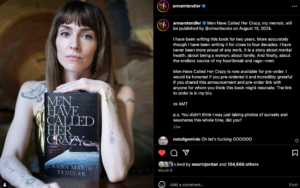The following is the script of a YouTube video. If you would like to watch or listen to this in video format, you can do so by following this link. If not, then keep reading below.
On July 20th 2024, The Sunday Times Magazine published a story called “Meet the queen of the ‘trad wives’ (and her eight children).”
To write this article, a British journalist based in the U.S. named Megan Agnew traveled to rural Utah to meet a woman named Hannah Neeleman, more commonly known by her famous TikTok account handle, Ballerina Farm. On social media, Hannah Neeleman posts images of her photogenic, ten-person family, helping her cook and tend to the animals on their enormous, homestead farm. The image that she portrays is idyllic and loving, a relic of a more traditional time when kids spent more time running through fields in long dresses instead of sitting in front of iPads at TGI Fridays.
But when the journalist, Megan Agnew, visited the Neeleman farm, she started to notice the signs of something much darker peeking out from behind this domestic paradise. For example, Hannah revealed that her current reality, which so many followers aspire to, was never truly her own dream. Her real dream, of being a ballerina, was put to bed when her husband, Daniel, the son of a billionaire, insisted that they get married and start having children before she had graduated from Julliard. Both Daniel and Hannah come from a very religious Mormon background, and the couple got married after dating for only three weeks. Hannah also admits that sometimes, she feels so exhausted that she can’t leave her bed for weeks at a time.
The article about Hannah Neeleman, written by Megan Agnew, came out and immediately went viral. The piece was very well-written, and it started a wider conversation about the trend of “trad wives,” short for “traditional wives,” who are women on social media who uphold a certain aesthetic; an old-school portrayal of motherhood with homemade food, 50s-style dress, and traditional gender roles in the sense that the women in these arrangements tend to the home and the children rather than holding salaried jobs. But after the article came out, Hannah Neeleman posted a video calling it “an attack,” and even responders on the left accused the journalist, Agnew, of biased journalism. [FunkyFrogBait 5M views video.] I will address those accusations later on.
So right when this article was going viral and causing a lot of conversation about trad wives on social media, another article came out that flew a little bit more under the radar about another influencer. This one lived over on the east coast.
Whereas previously we spoke about a trad wife, homesteading, rural aesthetic, there are other influencers with a different image: this one of New York City, fashion, movement, money, and glamour. A notable figure among this group was Candice Miller. Candice Miller started a fashion and lifestyle blog called mama and tata with her sister, Jenna Crespi (Candice is the “mama” and Jenna is the “tata” which means auntie in French). Their site aimed to teach women “how to be a great mum while maintaining beauty, style, and glamour in everyday life.” Candice Miller is a well-connected socialite, cousin to the fashion influencer Arielle Charnas, friend to the Olsen twins and Ivanka Trump, and the host of some of the most elaborate and costly parties of the Hamptons’ inner circles.
Then, on July 3rd, 2024, Candice Miller’s real estate mogul husband, Brandon Miller, committed suicide in his Porsche in the garage of their 15.5 million dollar Hamptons mansion while Candice and their two little daughters were vacationing on Italy’s Amalfi Coast. In the wake of Brandon Miller’s death, it was revealed that the money used to maintain their elaborate lifestyle did not exist. The family was tens of millions of dollars in debt, and virtually none of the luxury that appeared on Candice Miller’s Instagram page, from the boat, to the house, to the furniture, actually belonged to them.
I want to compare these two articles, each of which involves a journalist who sought to remove the sheen of filters that covers the lives of famous influencers and their families. And toward the end of this video I go into a discussion about traditional gender roles and how we engage with them on social media.
Summary of “The Queen of the Trad Wives”
So, first, we’re going to go through Agnew’s piece about Hannah Neeleman and specifically we’re going to address some of the accusations that her personal bias affected the quality and integrity of the article.
This piece was published in The Times Magazine– not to be confused with the New York Times, which is actually much younger than The Times and The Times is based in London.
Two categories that exist in journalism are “straight” journalism, and “immersive” journalism. Straight journalism is what we usually associate with journalism; it’s an objective, third party report. Thems the facts. And the second essay that we’re examining today is straight journalism. But this essay, “The Queen of the Tradwives,” is immersive journalism– it is a profile of Hannah Neeleman. The journalist speaks in the first person about her experience of meeting someone and what her impression of that person was.
When I see people criticizing Agnew’s bias in this article, I almost feel as though they judged it as if it were straight journalism. But this was never meant to be a completely objective report. In an immersive profile, it is well within the bounds of the task of the writer to comment on their experience and their impression of the person in front of them. But there is still a line. You can write about what a person said to you and what your experience was like of hearing it, but you typically can’t step back and start to proselytize about your own views. I couldn’t be writing about my experience with Hannah Neeleman and all of a sudden be like, “Hannah Neeleman belongs to the Church of Jesus Christ of Latter Day Saints– And you could too. Follow this link to get a free Book of Mormon.”
That said, in immersive journalism, there is an added dynamic. The presence of the journalist changes the story, because the people there react to the physically present journalist. Remember that for later.
My opinion is that this article is very particularly and expertly structured, and the structure of the writing of the article aligns with the structure of the photography. Let me explain.
When I first saw this image at the top of the article, I thought it was a strange choice for the featured photo. The backdrop is expansive and breathtaking, it really shows just how much land they own. The children are even more beautiful than the backdrop, and they’re in noticeably gendered clothes, with the girls in long dresses and cowboy boots and the boys in collared shirts, jeans, and enormous belts. It’s such a great photo, but it confused me because Hannah’s face is obscured. And she’s really the only one in the photo with an obscured face. And at first I thought, well, there are so many people in this picture, most of whom are little kids, so it’s probably just really hard to get a picture where everyone is looking nicely at the cameraman. Still, it’s strange that the star of the show is the only one who didn’t get her full face to be in the picture.

But then I realized as I went down the article, that the photographer and the writer may have made this decision intentionally. The writer in this article carefully peels the curtain back on this “flawless” life bit by bit until, in the end, the curtain is flung wide open so you can see what’s behind it. And I believe that the photography follows that slow descent as well in harmony with the writing, starting with gorgeous photos of Hannah Neeleman, then, in each photo, obscuring her identity a bit more. I’ll explain as we go through.
The first two paragraphs read:
“Hannah Neeleman was pregnant with her eighth child and she had two due dates. The first was for a baby, obviously. The second, just under two weeks later, was for a beauty pageant. Neeleman had been crowned Mrs American in August 2023 at a Las Vegas mega-casino and resort, so she was invited back to the city to compete in Mrs World, parading around the stage in a swimsuit and 5in heels, shoulders back and hip popped, spray-tanned, glistening — and 12 days postpartum. Obviously.”
Someone could argue that the tone, specifically with the two “obviouslies” is condescending, but I disagree, I think it’s just a more British writing style. British writing tends to be a bit more snarky, a bit more subtle, it’s why they can be so much better than us at the honest and bitter art of dark comedy (Fleabag, Baby Reindeer, Martin McDonagh) and we can be so much better than them at the more bombastic and in-you-face art of spectacle (Lion King on Broadway, Rockefeller Christmas Tree, the eras tour, end game). When I’m editing for work, I do tend to discourage writers from over-using phrases like “of course” and “obviously,” but in this case, I think that it’s more of a joke to point out the absurdity of the situation so I think it’s fine.
Agnew goes on to explain the intense beauty regimen that a very pregnant Hannah Neeleman subjected herself to in order to look so “perfectly pretty” in time for the beauty pageant that was, again, two weeks after the birth of her daughter. She took ice baths in the irrigation ditches on her farm, she took iron supplements, and she woke up early to lift weights. She had her daughter, like most of her children, without any pain medication, and two weeks later she was able to zip her swollen, bleeding body into tight leather pants and sequined gowns, she got a spray tan, and she flew to Vegas with her newborn and family of ten to participate in a “who is the prettiest girl” competition. When a photo was released of Hannah Neeleman nursing her brand new baby girl backstage at the beauty pageant, her social media blew up and she was crowned “the queen of the trad wives” by her millions of followers, even though Hannah herself never called herself a trad wife. And now, with the backstory, we go into Agnew’s interview with Hannah Neleeman.
Agnew published a piece after the fact that gives us a little insight into her mindset when she first went to interview Hannah. She wrote:
- “I was desperate to know how she felt about all the controversy and anger which followed her around the internet.”
- “There were so many things I wanted to ask which were inappropriate to do so in front of her husband or young children — about contraception, married life, the trials of motherhood, or just simply who she was and what she thought when she was away from it all.”
So that tells us that Agnew arrives wanting to do a profile on Hannah. She wants to get her alone and ask her pointed questions. Spoiler alert, she will not be able to.
Now at this point in the article, I start to notice something strange in the writing. Agnew is referring to Daniel Neeleman as Daniel, and Hannah Neeleman as just “Neeleman.” I thought that was bizarre, usually the way you would refer to a couple would be parallel, so both by their first names or both by their title and last name. In some really old school publications, you’ll see women referred to by their first names and men referred to by their last names, but even that is being phased out and I don’t think I’ve ever seen a publication call the husband by his first name and the wife by her last name. So I bought The Times Style Guide to see if we’re breaking any rules here, and here are their most modern standards about titles:
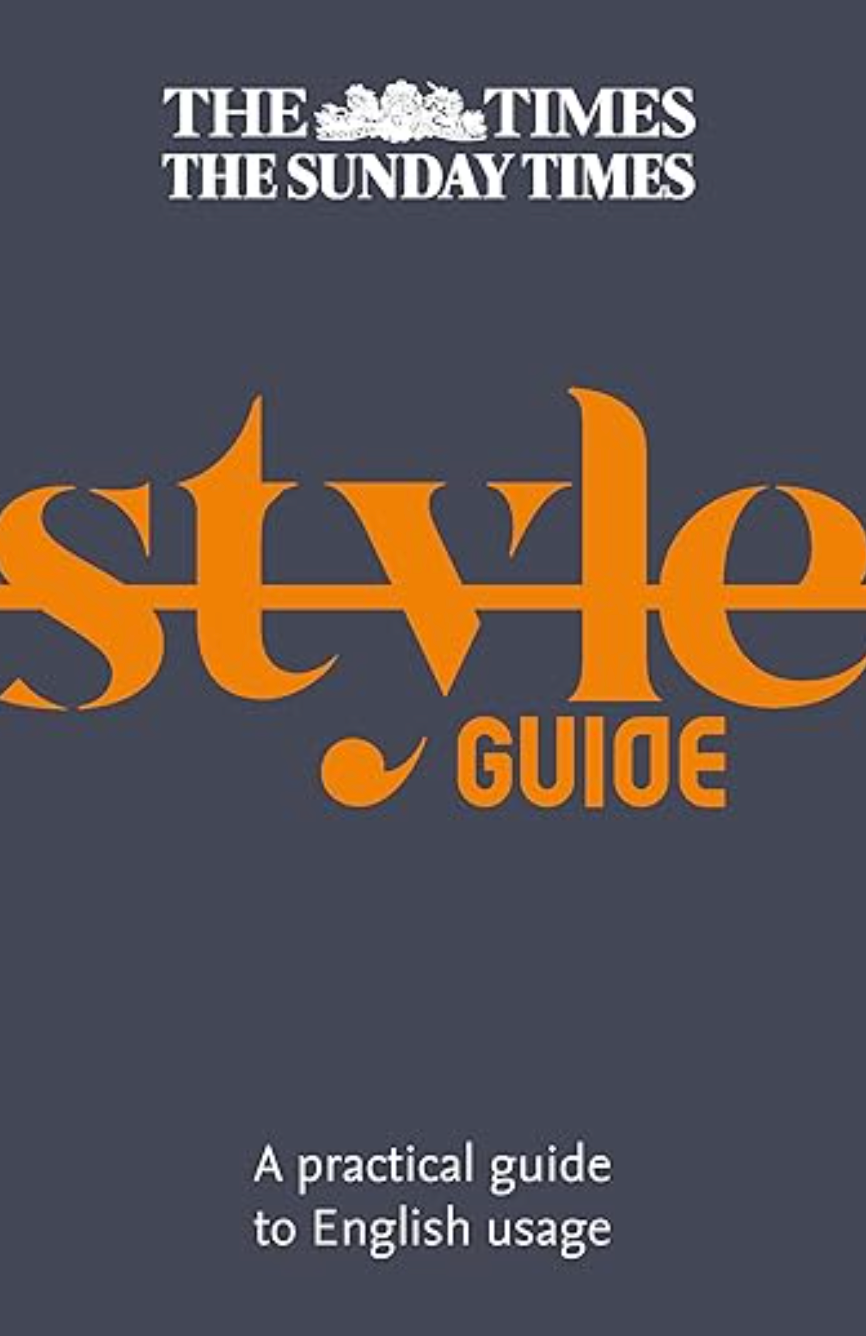
“Everyone will be referred to by surname only (except for children: first name until the age of 18).”
“If you need to distinguish between a husband and wife, you can use a title to do that.”
So, based on my interpretation of the style guide, we are breaking the rules here. Hannah and Daniel should be Mr. Neeleman and Mrs. Neeleman. So I wonder if Agnew is using this subtle change to bring our focus to Hannah as the subject of the article and as an individual, independent of her husband and family, or to quietly show an alliance with Hannah. But with how serious writers and editors can be about titles and honorifics, I seriously doubt that this was done unintentionally.
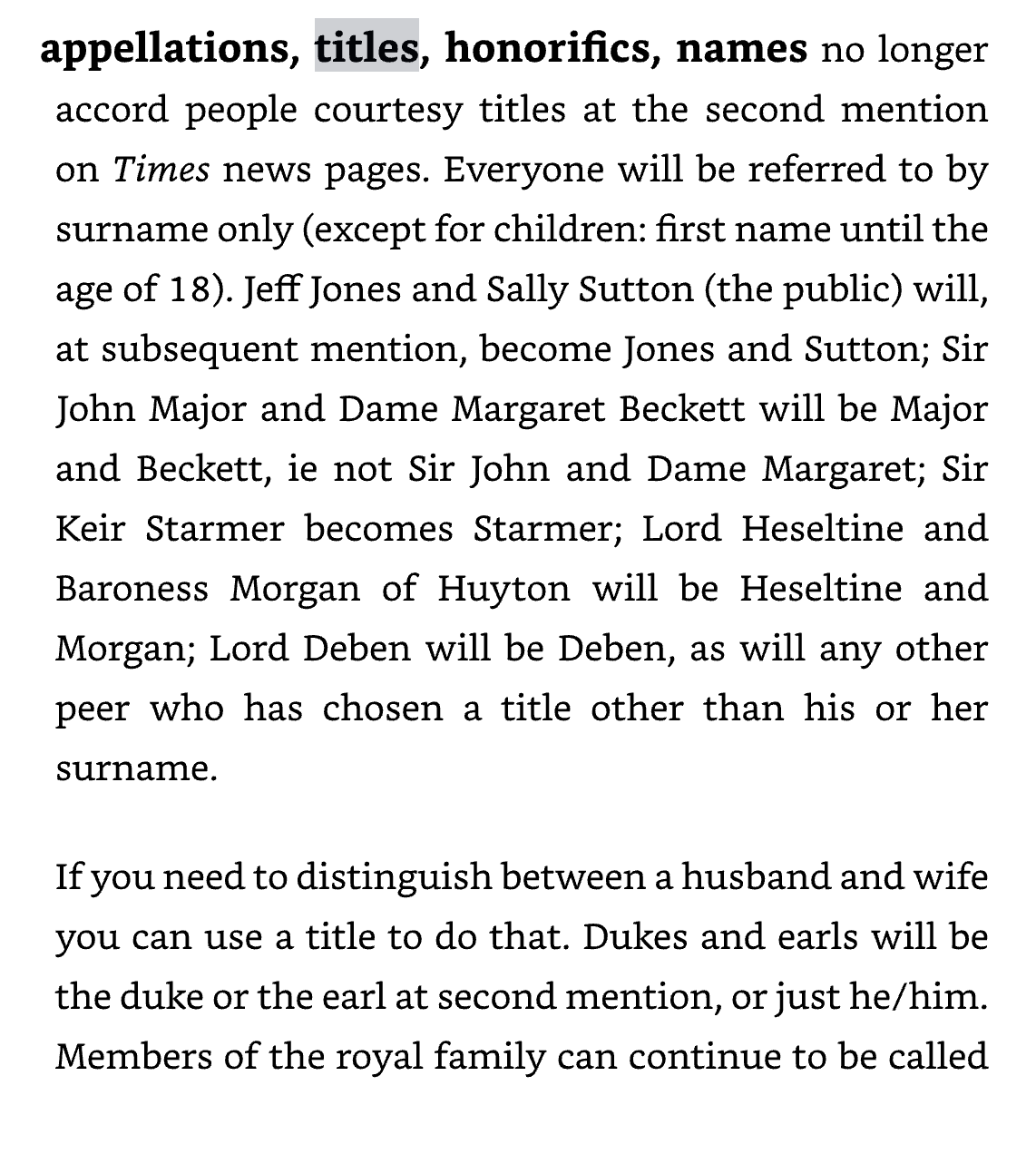
Now, herein begins the descent that I mentioned earlier, made visible by the photography.
At the beginning of the article, Hannah Neeleman is the super mom and her husband the valiant cowboy: the same image that many readers have seen on their social media accounts. The way Agnew describes the couple is fantastic; she says that Daniel Neeleman is “an all-American steak of a husband, square-jawed and denim-clad” and Hannah Neeleman is “a tiny blonde beauty queen, her hair wet and cheeks flushed, impossibly pretty.”
Hannah was able to compete in a beauty pageant just a few days after giving birth. Her children are present, but the writing frames it as the children are “swinging off her long golden hair.” At this point in the article, the photos reflect this image of the couple.
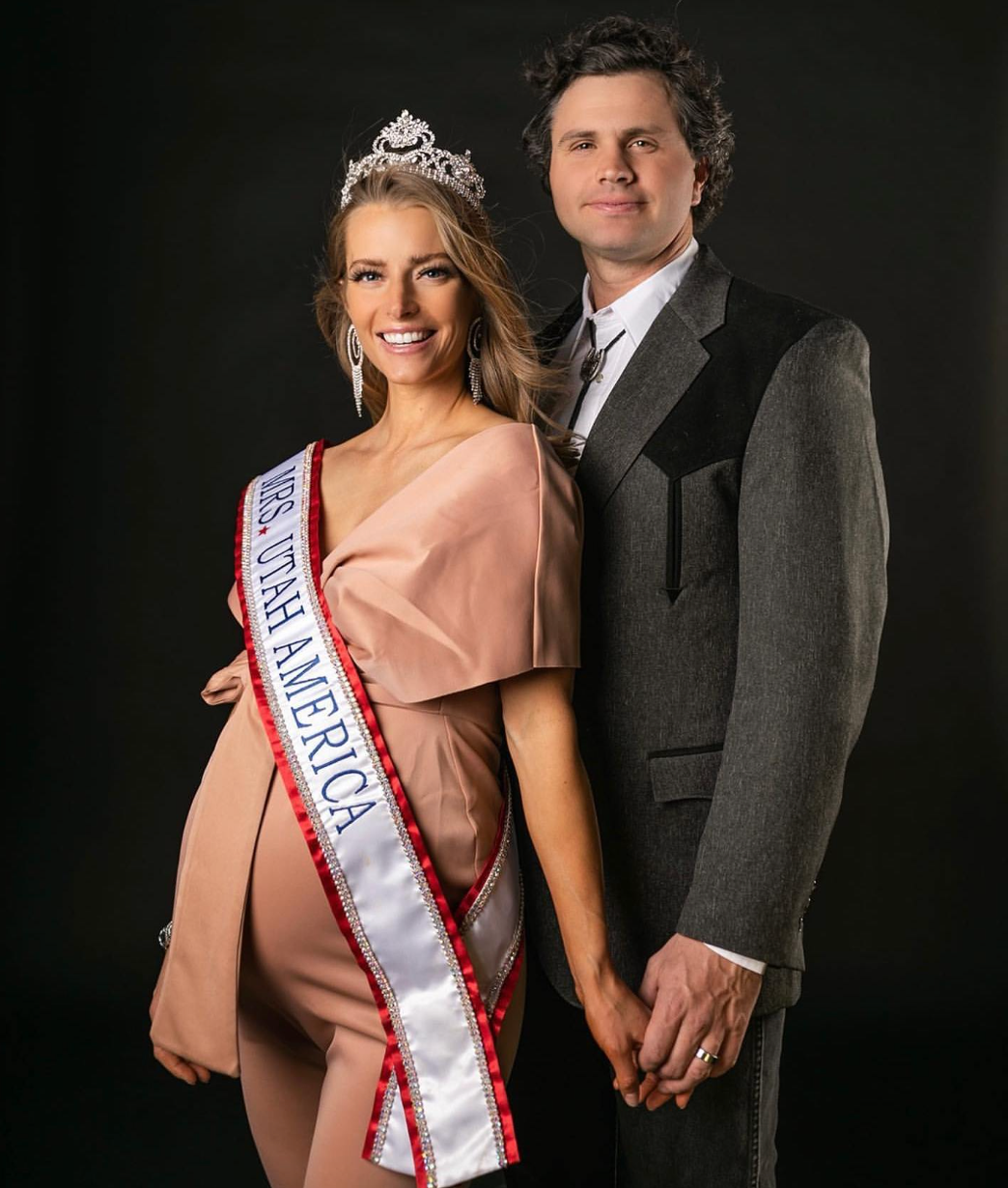
This is one of the first photos we see in-text. The couple is united, well-dressed, in clear sight. Hannah wears her Mrs. Utah America sash over her pregnant belly, which her glamorous outfit has been tailored to fit, as her hair blows in the wind even though she is inside.

The next photo shows Hannah serving homemade food to her children in a wooden kitchen while she smiles. The colors are perfectly balanced, steam comes off the spaghetti, and Hannah is the star of the show as all of her children sit patiently and look to her for their dinner.
Agnew shares that Hannah is “A devout Mormon who was raised in a Mormon family, she bakes perfectly scored sourdough loaves, milks cows straight into her coffee cup and gives birth by candlelight with no pain relief.”
But already at this point, our writer starts laying the groundwork for the descent back to reality that is to come, just as the featured photo foreshadowed. Agnew starts including these little hints of something else; something that isn’t so picture-perfect. First, she mentions that Hannah is repeating lines that are fed to her by Daniel. Then Agnew poses a question about Hannah’s feelings about negative comments, only for her to turn to Daniel and ask him about what upsets her. Then Daniel is standing behind her and simply answering questions for her. It’s still not too concerning yet, but it affects the feeling of the article. It’s almost as if Daniel is looming over everything she says.
When Agnew asks the couple if they like it when Hannah is called a “trad wife,” Daniel says yes, while Hannah cautiously disagrees and points out that it’s not an entirely accurate label. So now it seems that Hannah is uncomfortable, and as the reader, I’m starting to feel uncomfortable as well. The writer is painting a tension here– a disconnect in how the husband and the wife feel about being called “traditional.” Daniel seems fine with it, but Hannah does not. Later, they get in a 15-seat car and Agnew asks if they hope to fill it with children. Daniel says yes immediately. Hannah says that she is feeling “tired and worn out.”
Around this time, the photos start to change. Now, as the writing is painting an image of Hannah as more tired, more burdened, the photographs also start to show more work and fatigue. We watch as Hannah milks a cow. We see how her young son holds her littlest baby so she can collect milk. We see her with her youngest strapped to her chest while she leads a cow. Just like the writing, the changes are still subtle. Hannah and her kids still look gorgeous, but now, the photos aren’t quite so effortless; not nearly as glamorous. Her facial expressions are a bit more concerned, like there is more of a weight on her shoulders, compared to the glossy smiles we saw before. Let’s continue.
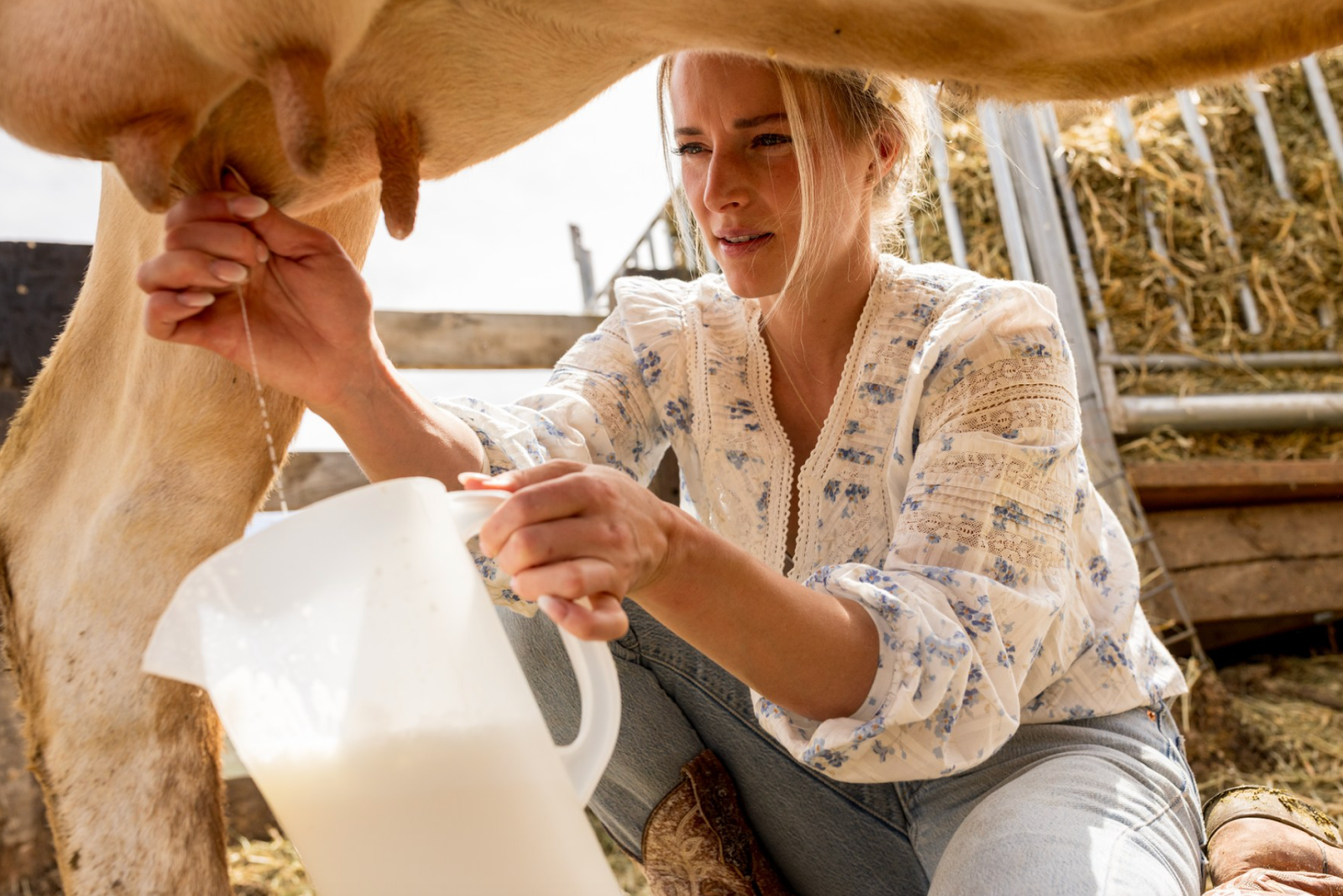
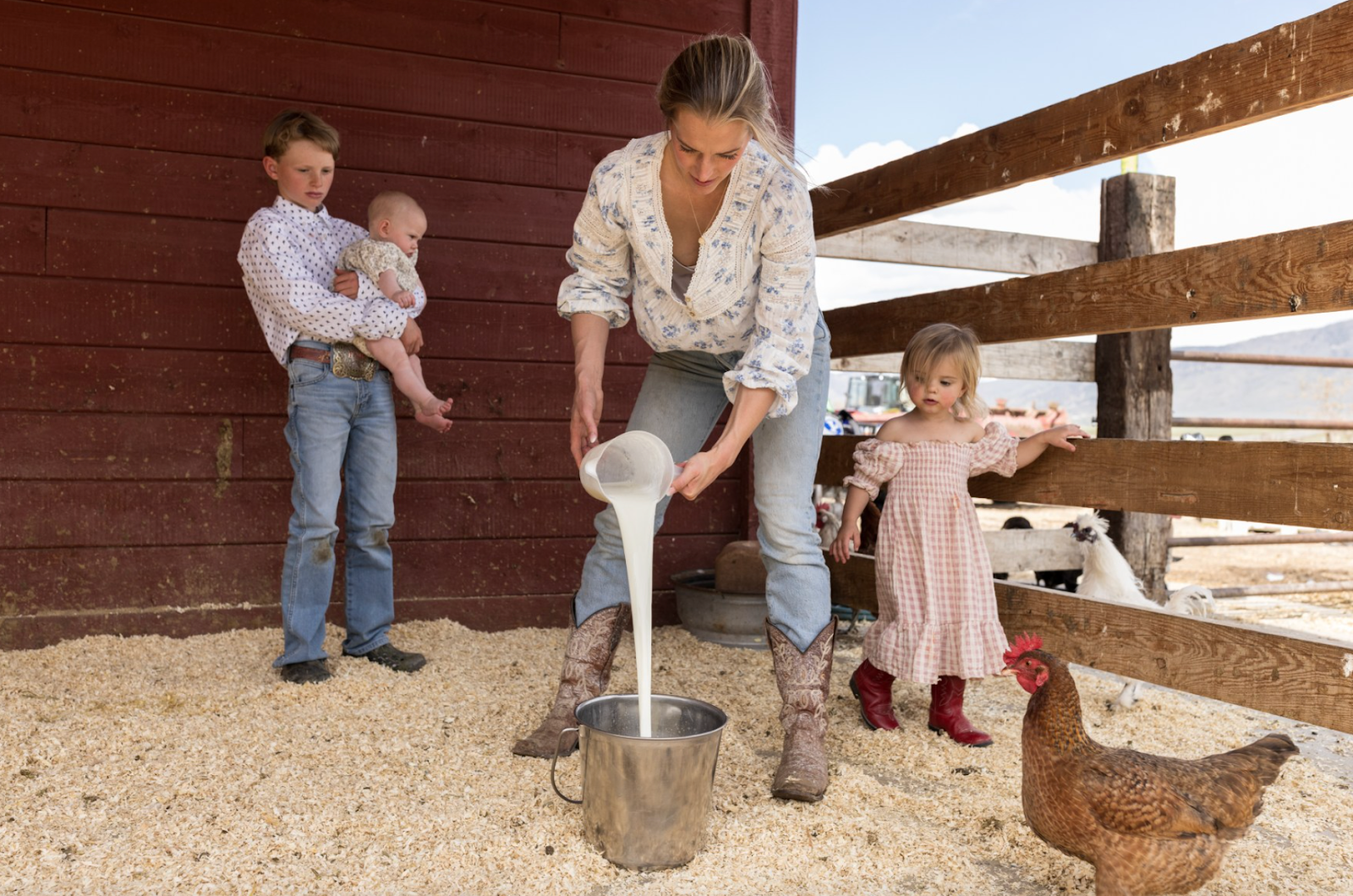
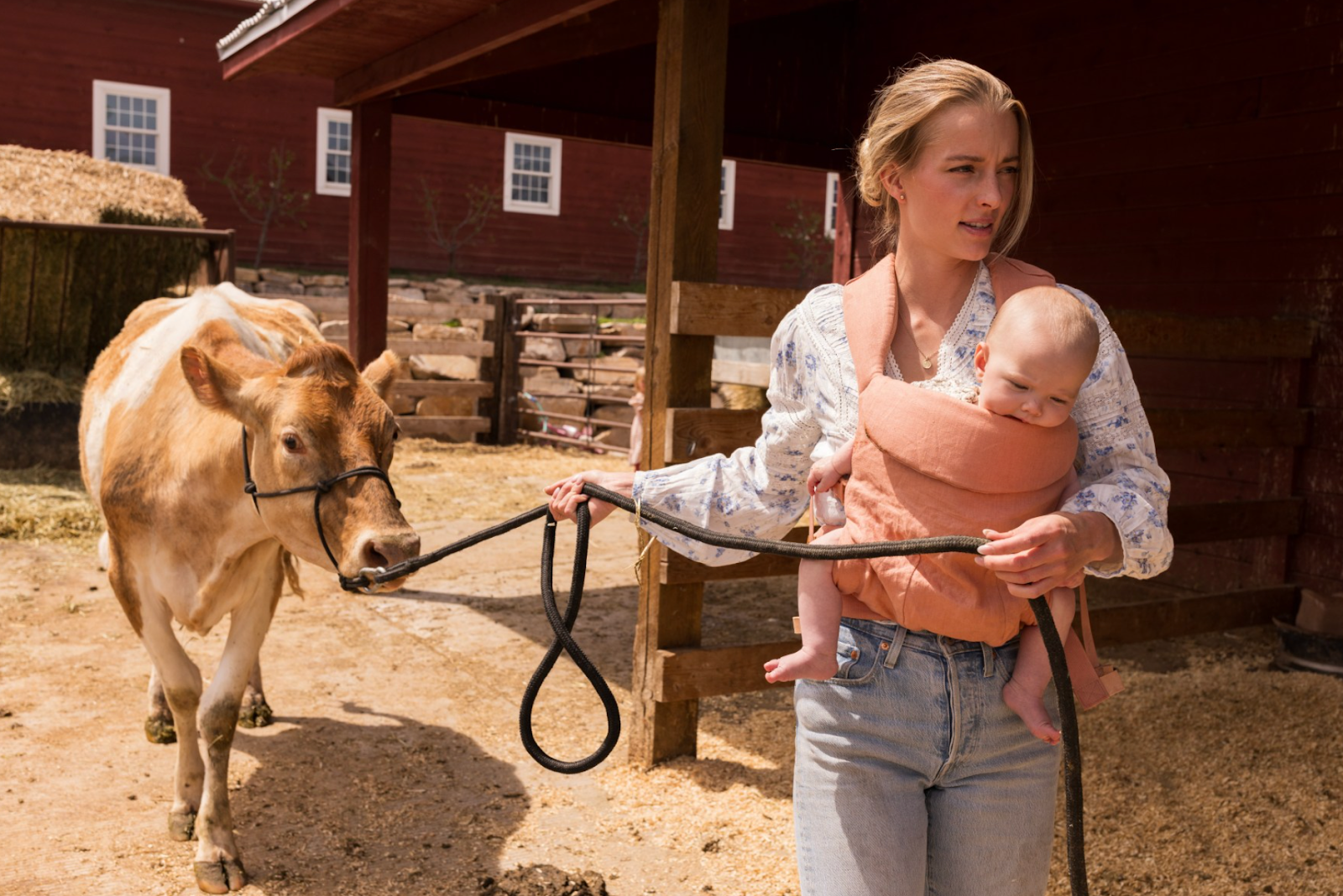
Finally, Agnew gets a moment alone with Hannah, so she starts to ask more pointed questions. And now we learn about Hannah’s backstory. As a person, not just as a mom and farm hand.
Agnew asks her, “Is this what you always wanted?” And Hannah says, “No.” Then she catches herself, and says, “I mean, I was, like —” She pauses. “My goal was New York City. I left home at 17 and I was so excited to get there, I just loved that energy. And I was going to be a ballerina. I was a good ballerina.”
(By the way, when Daniel walks back over, and Agnew poses the same question, “Was this what you always wanted?” Without pausing to think, he says, “Yes.”)
Hannah’s parents were Mormon, with nine children, Hannah was the eighth. She was home schooled. Her parents were florists, so she didn’t grow up with a ton of money, but she showed a lot of potential and talent in ballet from a young age. So she competed in beauty pageants that offered scholarship money so that she could afford to go to Juilliard, in New York City. Juilliard is one of the greatest music schools in the world and usually considered to be the best in the United States. Their dance program accepts only 12 women each year. So when Hannah Neeleman said, “I was a good ballerina,” that’s not true. She was an exceptional ballerina.
Hannah’s husband, Daniel, also grew up Mormon, and was also one of nine children. But he grew up in very different circumstances. His father was the founder of JetBlue, making him a billionaire. When Daniel was 23, he saw 21-year-old Hannah at a college basketball game and spent six months asking her to go on a date with him, but she repeatedly refused him. Then, Hannah mentioned she was flying back to New York from Salt Lake City, and Daniel realized she was flying with his father’s airline. So he pulled a few strings, made a few phone calls, and got himself on the seat directly next to her. She thought it was a crazy coincidence, but it was really Daniel’s work behind the scenes. The two started dating.
Hannah told Daniel that she wanted to date for at least a year so she could finish school. Daniel told her, “That’s not going to work. We’ve got to get married now.” So one month after Daniel sat next to Hannah on her flight, they were engaged. Two months later, they were married, and three months later she was pregnant. She finished her undergraduate degree at Juilliard with her pregnant belly, then Daniel moved his family to Brazil where he would work for his father.
Hannah’s Blog
We’re going to step away from Agnew’s article for a moment because Hannah actually kept a blog during this time that paints a more honest picture of her experience living in Brazil.
Hannah doesn’t speak Portuguese, and the couple at this time only had one car. Daniel took the car to work every day, many days working from 7:30 AM to 10:30 PM, which left Hannah alone and isolated in the house with her newborn. I’ve actually lived in a country where I didn’t speak the language before and I also became quite isolated, and I was very fortunate at that time to have a job in person, because it got me out of the house and helped me get that social interaction that we all need. But Hannah writes in her blog that she didn’t leave the house for weeks at a time. She wrote that she starts to get depressed, usually around Wednesdays, because that’s when she feels the effects of not leaving the house for a few days. Of course, during this time, Hannah was forced to give up dance as well, which had been her passion since she was a child. She told Agnew in her profile that giving up dance felt like giving up “a part of [her]self.”
Some other things that Hannah wrote in her old blog include:
“Sometimes when Daniel’s schedule gets very busy and I’m left to handle momhood on my own in a place where I still can’t communicate, it gets very overwhelming.”
“We live about an hour and a half away [from Daniel’s work] and therefore never see him. This week has been especially bad, I mean, leaves at 8 am and doesn’t get home till almost midnight bad. Poor Henry hasn’t seen daddy all week… It’s terrible, absolutely terrible.”
“I may or may not have had a major meltdown yesterday and told Daniel I was running away. It was quite the meltdown…”
“The last few days have been especially hard for me. As much as I want to speak Portuguese, I can’t. And it gets lonely. Really lonely. … I have been on my knees a lot lately. This morning I found myself on my knees, my cheeks wet from tears, asking for a friend. Just one. Just someone to talk to.”
It’s clear from these blog posts and from Hannah’s history that she is not only a mom and a homesteader, she is also an artist. And her chosen art form was one that you create in community. When you sing with a group of people, dance with a group of people, create shows or theater or become part of an orchestra, there is something about that specific social activity that causes a group to become very close and very in tune with one another. And if we add on top of that that Hannah always had a ton of siblings, a religious community to depend on, and, for her whole life, a studio of dancers who she created with and expressed herself with; to go from having such a close, intimate community of people to being stuck in a house with little kids and no one her age to talk to, well, of course it was shocking for her nervous system.
And being newly married can be tough; it can require a lot of work, especially if you only knew each other a few months before getting married, there is a lot of negotiating that goes on in those early days while you build the marriage that you both want to have– a lot of defining boundaries and a sort of power struggle sometimes and doing that in a foreign country where you don’t speak the language with multiple infants and have no girlfriends who you can vent to can make that process all the more complicated. So, compared to this situation, I’m glad that now the couple gets to spend so much time together and I was pleased to read in the profile that Agnew’s impression was that Daniel is very involved with the kids; that very well could have been something that Hannah negotiated with her husband and something that was important to her. But I do think that these blog posts offer a very interesting window into who Hannah is and what is important to her. Because even today as a social media star, she still doesn’t get to dance, and she still lives in a very physically isolated location, so I ask myself if her dedication to social media possibly came from an intense loneliness that appears to have plagued her adult years.
Back to the Agnew article, at this point, the mask starts to really come off, and Agnew starts to editorialize more. Hannah says that she wasn’t the only one who had to make sacrifices when they had kids, specifically in reference to giving up dance, but, in her writing, Agnew admits that she disagrees with Hannah. She writes:
“Daniel wanted to live in the great western wilds, so they did; he wanted to farm, so they do; he likes date nights once a week, so they go; he didn’t want nannies in the house, so there aren’t any. The only space earmarked to be [Hannah] Neeleman’s own — a small barn she wanted to convert into a ballet studio — ended up becoming the kids’ schoolroom.”
So our writer is now directly pointing out that Hannah might not be a completely reliable narrator of her own life. She’s writing a story about the erasure of Hannah’s identity as an individual. Do I think the journalist is crossing a line here? I don’t. I think that, again, because this is a profile and an immersive journalism piece, Agnew can share her opinion and her impression of the couple beyond just what they say about themselves. It’s up to us as readers to decide if we agree with it or not, knowing and understanding that this is the journalist’s personal interpretation.
Then, we get a pretty major reveal when Daniel says that Hannah sometimes, “gets so ill from exhaustion that she can’t get out of bed for a week.” Of course I don’t know these people personally, but many readers commented that Hannah seems to be navigating some pretty serious symptoms of depression and burnout and many readers rightfully asked, if your husband is the son of a billionaire (and you’re both pretty wealthy in your own right from your farming business and social media), then maybe you could hire her more help around the house, take a nice trip without the kids, or at the very least maybe stop having children.
Finally, Daniel leaves to take a phone call and Agnew gets a little time alone with Hannah. Hannah shares that her first two children were born in a hospital, then Hannah said: “After that I was, like, I’m ready to go back home. I just love having them at home. It’s so quiet.”
Agnew asks Hannah why she has her babies without pain relief, and Hannah responds, “I don’t know, I just have never loved taking it. Except with Martha — I was two weeks overdue and she was 10lb and Daniel wasn’t with me … ” She lowers her voice. “So I got an epidural. And it was an amazing experience.”
“Where was Daniel that day?” Agnew asks, and Hannah says: “It was shipping day and he was manning the crew.” Agnew adds: “But the epidural was kind of great?” Hannah pauses — and smiles. “It was kinda great.”
The reader is catching on by this point that there has been a sort of expunging of Hannah’s identity and individualism, but now we’re also starting to wonder if there is a specific antagonist behind the erosion of Hannah’s self. Agnew continues:
“I want to ask her about birth control, but we are surrounded by so many of her children and Daniel is back in the room now too. Do you — I pause and look at her fixedly — plan pregnancies? “No,” Daniel says. “When he says no,” Neeleman responds gently, “it’s very much a matter of prayer for me. I’m, like, ‘God, is it time to bring another one to the Earth?’ And I’ve never been told no.”
“But for whatever reason it’s exactly nine months [after a baby] that she’s ready for the next one,” he says.
“It’s definitely a matter of prayer,” she says.
“It’s a matter of prayer but somehow it’s exactly nine months,” he says.
Agnew then tries to ask about their stance on abortion, but a child interrupts, shouting mom-mom-mom-mom-mom I want to go to ballet now! So Agnew writes the paragraph that could be pushing the boundaries when it comes to personal bias:
“I can’t, it seems, get an answer out of Neeleman without her being corrected, interrupted or answered for by either her husband or a child. Usually I am doing battle with steely Hollywood publicists; today I am up against an army of toddlers who all want their mum and a husband who thinks he knows better.” In my personal opinion, I think that this is where she crosses the line into sharing a bit too much of her personal thoughts and emotions. I think that Agnew has been peeling the curtain back bit by bit through this whole article and now the curtain is wide open and because she wrote the article in that direction, the logical conclusion of a piece that followed that structure is to bluntly state how she really feels about this man and Hannah’s situation. But I don’t think that she needed to. The rest of the article was so well written and the scenes that she painted and the dialogues that she included elicited this same feeling of frustration in me as the writer without her having to explicitly say that she couldn’t get time with Hannah without being interrupted. But to be clear, this one paragraph is really the only part of this article that I would re-work. The only other change I would make as an editor aside from softening this paragraph a bit would be changing the way we named and referred to Hannah and Daniel, either going for both of their first names, or following the style guide and calling them Mr. Neeleman and Mrs. Neeleman, but it almost seems that Agnew couldn’t stand to call Hannah “Mrs. Neeleman” in an article about her own identity buckling and folding underneath the pressure of her marriage and motherhood. Overall, I think that Agnew’s perspective in this article was quite fair.
I’m glad that Agnew finished the article with an effective antidote, not with an opinion:
Why, I ask before I leave, did she do those pageants in between babies? “Well, my sister called me and said, There’s a Mrs Utah, let’s do it together.’ Just to —” she gestures at the children around her —“break things up.”
And the sequined gowns? Well, they used to be in her bedroom cupboard, but with all of her stuff — and Daniel’s and Henry’s and Charles’s and George’s and Frances’s and Lois’s and Martha’s and Mabel’s and Flora’s — the cupboard got so full that there wasn’t any more room. So Daniel put them in the garage.
So Agnew managed to both begin and end her article with these perfect little microcosmic examples of how Hannah keeps getting pushed out of her own story.
To finish, I’d like to go back to the photography for a moment. The final photograph portrays Hannah again, this time standing alone. Remember we started with yassified Hannah, then campesina Hannah, and now in the final photograph we see her pretty face obscured. This is when I realized that the obscuring of her face in the first photo was also likely a deliberate decision, and similar to the writing of the article, we bookend her story with the vision of her as mysterious and interesting, but also only really half there, because her hair covers her face. And your hair can be such a symbol of your femininity and youth and fertility so there might be something to be said for the fact that her hair is what covers her identity and causes us viewers to wonder if she hadn’t been born a woman, if she didn’t have the pressure that comes with femininity in her community, perhaps she would have been able to pursue her art form and reach actualization and fulfillment as an artist and as a person, and have children, if that was what she wanted.
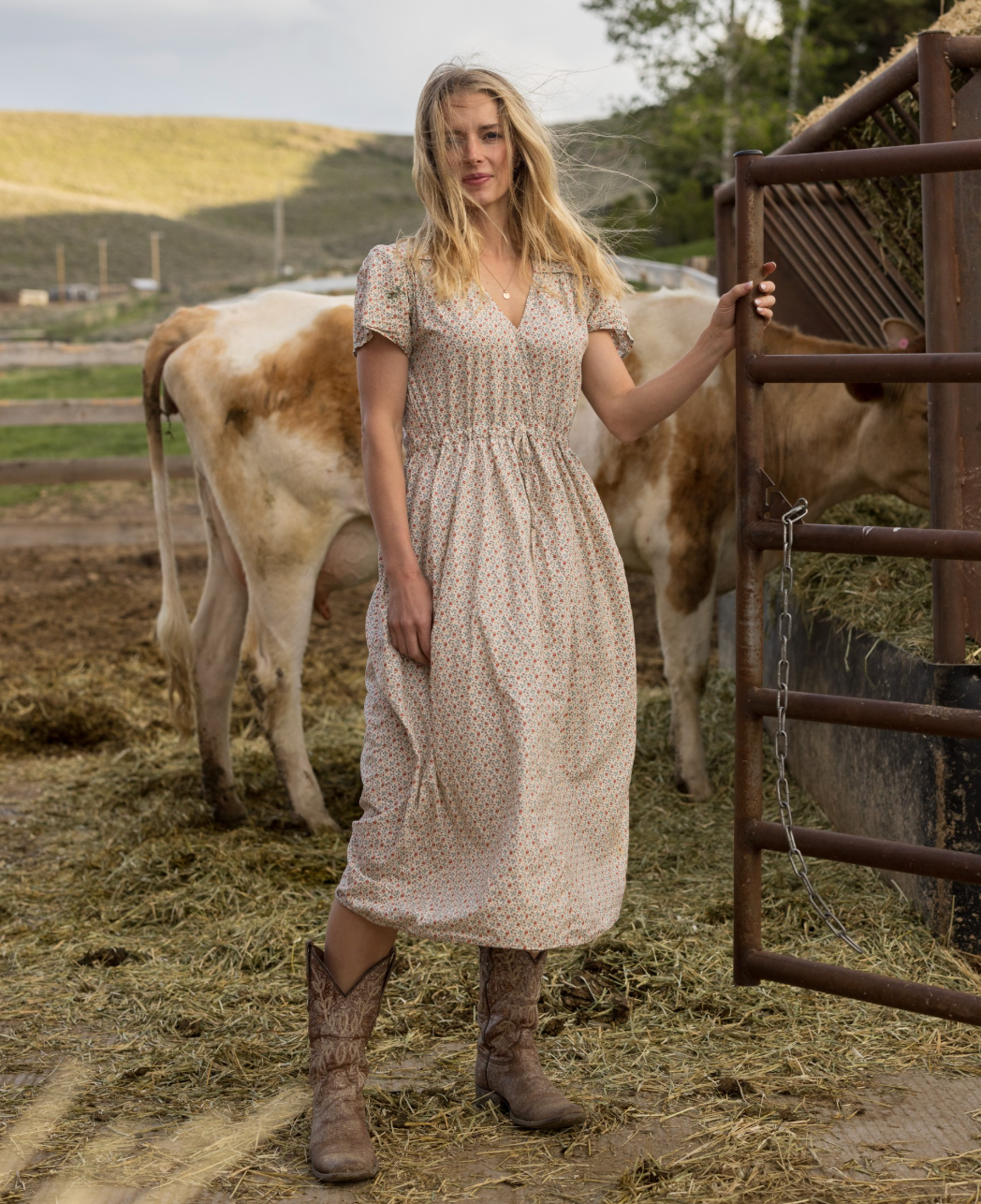
Discussion of the Article
So, I do not know these people, I don’t know anything about this couple aside from what I read in this article, so what I’m going to do is look at this article as an independent piece of literature and use it as a vehicle that brings us to greater discussions about marriage and feminism. I’m not saying that these discussions even relate directly to Hannah Neeleman and her husband, but there are likely people who follow them who have dealt with some of the things I’m going to mention so I still feel it’s relevant.
What Agnew is portraying in this work (again, not necessarily what Hannah Neeleman is actually living through, but what is being portrayed) looks to me like a psychological leash. Psychological leashes can exist in all sorts of relationships, but they most commonly exist in marriages or between a parent and child.
So take an example of a mother who puts a psychological leash on her son:
Let’s say the mother equates being needed with being loved. Or maybe she has been abandoned by other people in her life, and she fears being abandoned again by her child. So she, either consciously or unconsciously, puts a psychological leash on her child. She teaches her child that the outside world is scary and unpredictable, while depending on her is the only truly safe and comfortable place in the world. Her child goes out and has their first major failure in life. But instead of letting him work through that failure on his own and come out better (but perhaps less dependent on her) on the other side, she tells him, “See! The world is dangerous and unfair and there’s no use in trying. You should just come home and be with mama.” And yes the fault is on the mother for putting a psychological leash on her son and raising a man-child but it is also on the son for never taking that leash off and instead trading in his freedom for treats and belly rubs.
Now imagine the psychological leash of a girl, daddy’s little princess, who then grows up and the time comes for a transfer of power. What should be a transfer of power from the parents to their now-adult daughter instead often becomes a transfer of power from father to husband, especially if you’re in a community of people who tend to get married quite young.
Let’s expand on that example. A girl was on a psychological leash with her parents. Her parents were very strict and they instilled a fear in her about the world. They were especially controlling of her sexuality, who she dated, perhaps the way she dressed, her body, her appearance. For this girl, that criticism and that scrutiny feels like home. She internalizes it. She starts to apply these high standards to herself. When she speaks about control, she instead calls it “protection.” She seeks out partners who exert similar control; who have similarly high standards for her. She meets a man who has his own insecurities, as we all do. Maybe he was abandoned before by a parent (remember that if a parent is constantly working and never sees their kids, that can feel like abandonment for a little one, too) or maybe he was dumped by a different lover or maybe he has issues with his own self-worth and all of a sudden this woman comes into his life and she’s so beautiful and she comes from a nice family and she’s a fantastic dancer who goes to fricken Juilliard and maybe she’s impressive on her own accord while you worry that you are only impressive because of things that were given to you by an impressive father who has left some impossibly big shoes to fill and maybe after they get married her husband starts to worry that one day she’ll wake up and realize that she can do better and she’ll ditch his sorry ass. So there’s a dark insecure part of him that he might not even be conscious of that starts seeking out control. Maybe he does this by tearing her down in little ways, because he thinks that this will keep her dependent on him, make her afraid of living without him, and prevent her from leaving him behind. So he chips away at her confidence in herself so that slowly she gives him more and more power over her life. And in reality, the only way that you get better at doing things is by doing them and failing and doing them again so if her parents didn’t trust her enough to let her make mistakes and learn, then her husband doesn’t let her make mistakes and learn over time she really does become less capable and has less confidence in herself and after years of this behavior scraping away at her ability and confidence and sense of self she finds herself one day being asked how she feels about something in an interview and she can only turn to her husband and say, “How do I feel about that, Daniel?”
And I say all of this about the psychological leashes because often when people respond to trad wives, they say, be careful because that man could leave you, cheat on you, or abuse you, and if you don’t have your own finances and resume set up then you won’t be able to leave him. And that is a very relevant argument. But sometimes the consequences of a “traditional” relationship aren’t quite so dramatic. Sometimes, the issue is just a slow chipping away at the identity of one person in the couple, until eventually they become a supporting character in someone else’s life instead of the main character in their own.
Now, I do want to, not necessarily argue against myself, but add another perspective to this conversation. Hannah Neeleman is a performer, a social media star, a beauty queen, and a member of the Church of Latter Day Saints. So what I’m seeing here is a woman who is very image-focused and very trained when it comes to presenting herself to others, both physically and otherwise. When Megan Agnew came to Hannah Neeleman’s house, Hannah probably assumed or recognized that she was speaking to someone who is more feminist, modern, secular, and left-leaning than she is, and she probably thought of the audience of The Times in that way as well. If you’re English you might say, The Times is conservative leaning, but the Overton Window in the United States is shifted to the right, so The Times, and probably any European publication, would still probably be perceived as quite liberal by a true, red-white-and-blue-blooded, manifest destiny, God-fearing American Mormon. All of this is to say, I think that some of the tension that Agnew was picking up on in this interview wasn’t always necessarily the tug of a psychological leash from Hannah Neeleman’s imposing husband, but rather the tension inside Hannah of wanted to be perceived well by this interviewer sitting in front of her, and the interviewer’s audience, and her own audience and Mormon community. For example, Agnew asks Hannah if she considers herself a feminist and Hannah says, “I feel like I’m a femini-,” then stops herself, and then she says: “There’s so many different ways you could take that word. I don’t even know what feminism means any more.” To me, that doesn’t read so much as “I’m worried my husband will be mad at me if I say I’m a feminist,” (although it could be!) and it reads more like, “I feel like you, and probably other people, want me to say I’m a feminist, but I’m worried about how that will be perceived in my audience and among my family and friends.”
One famous line from this article is when Hannah admitted that getting an epidural was “kind of great.” But if you read the whole section, Hannah opens up about the fact that she got an epidural with one of her children, and Agnew says, “the epidural was kind of great?” And Hannah repeats, “it was kind of great.” Which makes it sound a bit like she was parroting the journalist, so I do have to wonder how much the presence of this journalist changed the dynamic of the family and the whole interview.
Still, if you notice, in all of these interpretations, what is consistently missing is Hannah’s own personhood. It’s always someone else’s wants and feelings prioritized, whether that’s her husband, her children, Heavenly Father, or us: the millions of eyes watching and judging her. That’s a difficult position to be in and I don’t envy it, but by worrying about others first and foremost, she might put herself in a perpetually losing position. Because you can’t make a million and one people proud. You can’t even make two people completely happy. But with introspection and focus, you can be proud of yourself, making self-love a far more reasonable goal.
Reputation Management Campaign
So, I always love the chance to witness a reputation management campaign in real time.
I’m not saying that the Neelemans are doing a reputation management campaign, but I will describe how a reputation management campaign works, then I will make some observations about the recent press about the Neelemans and you can come to your own conclusions.
I work in SEO which is search engine optimization, basically we help our clients come up higher on search engines and we do that by writing good content based around specific keywords. And every once in a while you’ll see something called a reputation management campaign. This happens when there is a negative story about some public figure, and they don’t want people to read it, but they can’t get it taken down, maybe because it’s in a really reputable magazine like The Times. So, what they do is they fill the internet with a ton of keyword-optimized stories that paint that public figure in a positive light or even just a neutral light until you banish that negative story to the third or fourth or fifth page of Google, and the famous SEO saying is that, if you want to hide a body, bury it on the third page of Google. (Google doesn’t have pages anymore but you know what I mean.)
When this article about Hannah Neeleman first came out, there was a huge explosion in traffic on this page and it was ranking very well, meaning that if you Googled Hannah Neeleman or Ballerina Farm, then this article would be one of the first if not the first thing that you found. Maybe you remember, this article made a big splash. But since this article came out, now, all of a sudden, there are tons of optimized stories about The Neelemans from these really high authority websites that are outranking or aiming to outrank The Times article.
For example, I’m not saying that the Neeleman’s PR manager paid The New York Times a pretty penny to write an article about them, but I will say that the recent article in the NYT about the Neelemans is so positive, it just sounds like a corny commercial. I mean one of their H2s is just “The life I always wanted,” which, to me, so clearly looks like a direct response to The Times article. And the final two paragraphs are:
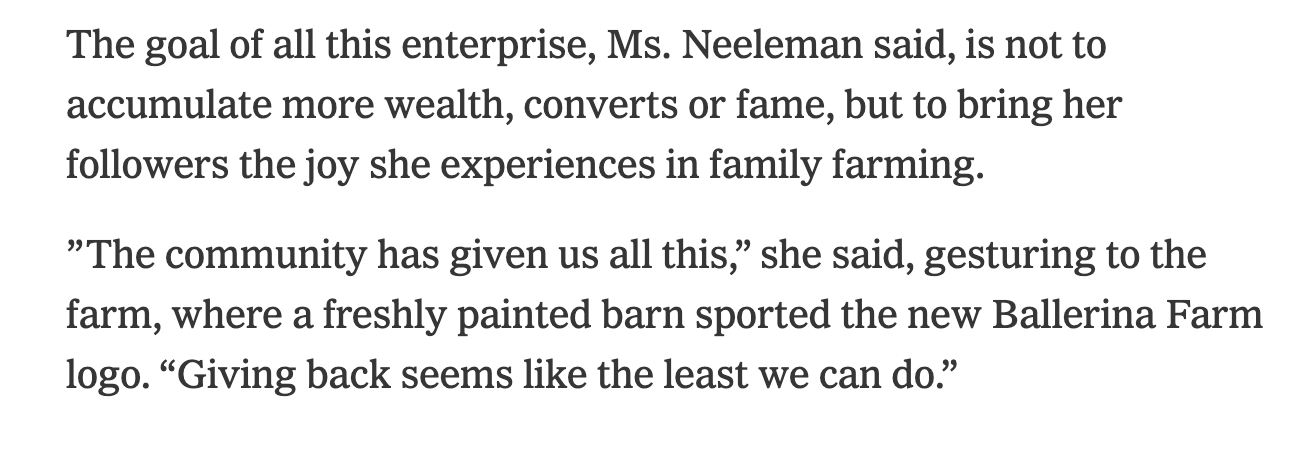
Awww.
And I’m not sure why they chose to mention this in the article, but here it is in black and white:

So they hired a publicist after the article came out and let me show you some data from Semrush which is software we use in SEO to track rankings.
This article was published in July and the traffic took off, peaking in September at around 27,000 views.
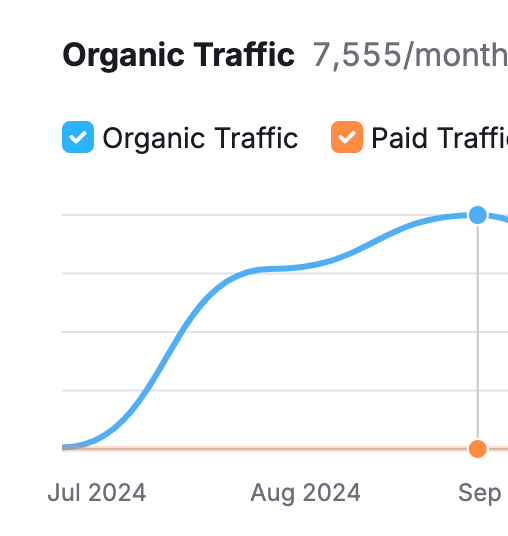

But now, if I Google Hannah Neeleman I get tons of complimentary stories that say things like “her husband is her steady rock.”
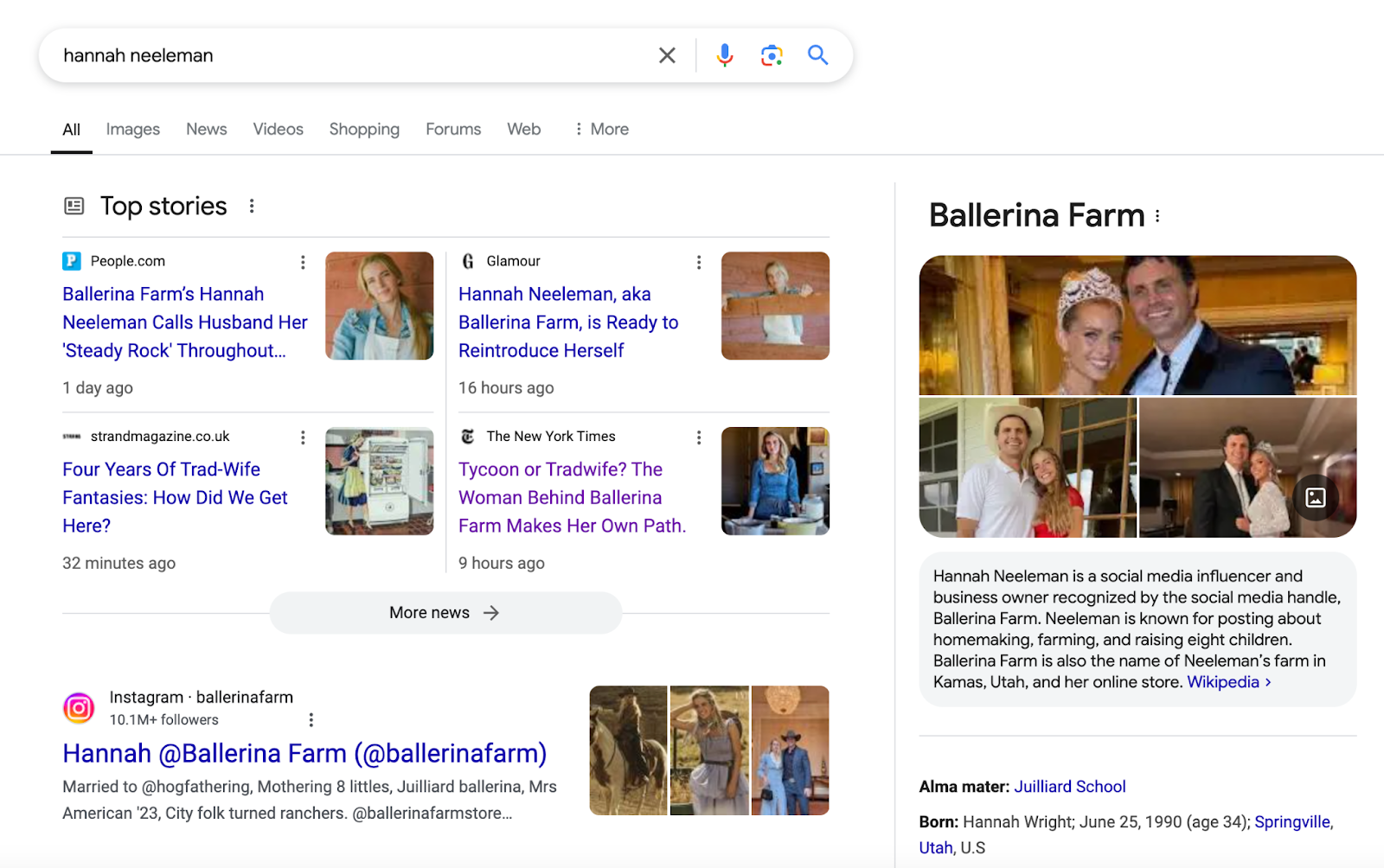
And now if I Google Hannah Neeleman then I have to scroll past 20-some stories to get to the one that I’m looking for. Again, not saying they’re doing a reputation management campaign, but if they are, then it was pretty effective, because the traffic on the “Queen of the Tradwives” article tanked, pretty suddenly. And if there’s a negative story about someone then all of a sudden there is a blizzard of positive stories about them, burying the first one then you might be witnessing some good SEO in action.
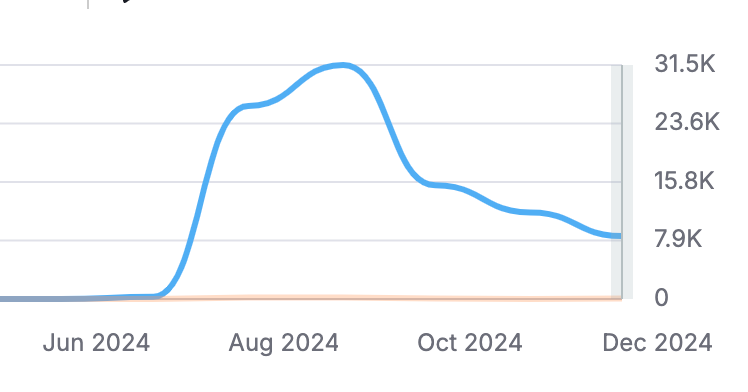
Agnew went deeper into the trad wife trend in her article and how it is one part of a larger social feeling. I will respond to that as well, but first let me share the next article with you so that it can contribute to and inform the discussion at the end.
“How an Instagram-Perfect Life in the Hamptons Ended in Tragedy:” Summary
This next article is a bit heavier and comes with a suicide trigger warning. This piece was published in the New York Times on August 8th, 2024. It’s titled “How an Instagram-Perfect Life in the Hamptons Ended in Tragedy” and it was written by Katherine Rosman.
Remember that whereas the last article was an example of “immersive journalism,” this article is “straight journalism,” so the journalist is not a first-person observer, she is instead, ideally, absent. So this article is shorter and a bit more dry, which could be better because that gives us a level of separation when dealing with subject matter that can be a bit emotionally taxing to discuss.
The subheading is: “Candice and Brandon Miller showed the public a world of glittering parties and vacations. The money to sustain it did not exist.”
The first paragraph reads:
“In the modern Gilded Age of New York, where Instagram is awash in unrestrained displays of wealth, Brandon and Candice Miller were royalty.”
Great hook– both of the articles that we’re looking at today had a great hook.
Then the journalist sets the scene that she presumably hopes will speak to the wealth and extravagance of this influencer and her husband.
For the 10th anniversary party of Brandon and Candice Miller, Candice threw a party with the theme Midsummer Night’s Dream, which is a Shakespeare play. Rosman the journalist, goes on to tell us a bit about the Mama and Tata Instagram account, with around 80,000 followers. Candice Miller was the host of this Midsummer party to celebrate her tenth anniversary, and at the party, she said to a lifestyle blogger at the party that her husband’s speech “made me cry by the end with his authentic, raw emotion and romantic words.”
While the last article started with the life that the influencer portrayed, then slowly revealed, bit by bit, what is really going on when the cameras are off, Rosman instead reveals the tragic end of the story toward the very beginning. After describing the Midsummer party and telling us a bit about the glitz and the glam of the mama and tata Instagram account, she then writes:
The Midsummer Night party was in 2019. Five years later, the glamorous image that Ms. Miller cultivated and promoted has disappeared, replaced with heartbreak, anger and a mountain of once-secret debt.
Her husband is gone. The home they so ostentatiously lived in, saddled by several mortgages, is not truly their own. Lawsuits from creditors, business bankruptcies, botched investments and even a repossessed boat — the “Miller Time” — indicate that the wealth needed to maintain their lifestyle had evaporated, if it ever truly existed.
Mr. Miller, 43, died on July 3 at a Southampton hospital. A suicide note indicated he had killed himself while his wife and children were on vacation on Italy’s Amalfi Coast.
The writer now finds herself in a uniquely difficult situation because the subjects of her article, Candice and Brandon Miller, on one hand, are alienated from the average reader by wealth and celebrity. The money that these people spend flippantly to impress their friends could change the lives of many people reading the article. Some people (and many religious texts) actually call this an immoral level of money hoarding. The writer must consider that there are likely people in her audience who are going through financial issues, like housing and food insecurity, a lack of accessibility to healthcare, very real, immediate dangers due to their financial situation. And maybe those people aren’t going to be particularly sympathetic to the influencers in her article who would happily drop $15k on a half-birthday party for their two year old. This reality creates a level of separation between the reader and the people they’re reading about. I would argue that a piece that doesn’t point out this separation, these absurd levels of spending and wealth inequality, is incomplete, and a journalist striving for a more objective profile ought to at least be aware of this absurdity.
Then, on the other hand, the writer has a task that may prove to be, even more difficult, which is to still, despite it all, recognize the humanity of these people. Because one of the subjects of this article, Brandon Miller, felt such levels of despair, and inner decay, that he couldn’t bear one more day as a human being, and so he chose to leave his two little girls without a father. And while we may not have ever touched the levels of opulence that Candice Miller flaunted on her Instagram account, most of us can, unfortunately, understand what those levels of despair can feel like.
The journalist who strives for objectivity, the writer who hopes to succeed in writing about subjects like this, subjects who on one hand are so separated from the average human experience and, on the other hand, have publicly suffered the uniquely human tragedy of suicide, must have the courage to criticize and comment on wealth and power inequality, but also must have empathy, a heart big enough to encompass even those most distant from us in terms of power and wealth who are, in this moment, experiencing crippling grief. So, courage, and empathy. I would argue that the best writers have heightened levels of both. If you want an example of a piece that struck this balance very well, I would recommend reading Taffy Brodesser-Akner’s 2015 GQ story about Justin Beiber joining a church. Brodesser-Akner acknowledges the silliness and absurdity of writing a story about this hyper-wealthy teenager joining this like hip, celebrity mega-church, but she also really grapples with Beiber’s humanity and gives a very empathetic profile of the pain he experienced that ultimately drew him to religion.
So, back to the article, the writer reveals that there was a business deal that Brandon Miller was hoping would save his family from their financial troubles and it didn’t go through, or so he wrote in his suicide letter. The New York Times reached out to Candice Miller for comment and a spokesperson said on her behalf: “Candice is devastated by the loss of her soul mate, and her two young daughters’ lives are forever impacted by the loss of their beloved daddy.”
The journalist discusses a little bit about how many people are discussing the Millers in The Hamptons at “the height of social season.”
Then she ends the intro by writing:
“A chasm separated the Millers’ shimmering public lives and painful private reality. But their fall is also a source of very real grief — a story about trying to have it all, and what happens when you cannot.
‘What people aren’t discussing in all of this is the loss of my little brother, someone I have loved unconditionally,’ Mr. Miller’s sister, Maurley Miller, said in a statement after being contacted by The New York Times. ‘I have a hole in my heart that will never be filled. I am completely devastated.’”
So what I see here is the journalist setting an intention for facing what she calls the “very real grief” of the situation. Since this is straight journalism, she is limited in just how much emotion she can put into this piece, so she’s instead using quotes from people who were affected by Brandon Miller’s death to fill in the gaps about how challenging this is for them.
The journalist goes on to set the scene of where these people lived, writing, “Perhaps no place in America is as perfectly Instagram-ready as the Hamptons, where striking natural beauty and extravagant wealth are juxtaposed in abundance.”
This reminded me of Agnew’s reflection on her day with Hannah Neeleman, an article she titled “My day with the trad wife queen and what it taught me” in which she wrote: “Just outside Kamas, it was one of the most beautiful places I have ever been, sitting in the crease between the fertile water meadows below and the arid mountains behind. It was made for Instagram.” So we have two very different locations, one in the Hamptons on the east coast and one that’s in the great wild west, and in both instances our authors take this awesome, truth-filled, natural beauty, and diminish it to a backdrop for Instagram photos, and I feel that they’re almost intentionally mocking the thought that something so expansive, infinite, divine, and powerful like the Rocky mountains or the Atlantic Ocean, places that confounded our ancestors and will outlive us by millenia, would exist just to provide the blurred background of a selfie taken in portrait mode.
For people like me who had never heard of the mama and tata Instagram account, Rosman gives a little background, saying that Candice Miller was once known for big spending. She shared many photos of private fitness sessions, private jets, Manhattan highrises, drivers, private chefs, and vintage designer gowns.
In one interview, Candice Miller sat in an all-white room with her two little daughters. The journalist writes that even the books on the walls had uniform white spines, which reminded me of the scene in The Great Gatsby when Jay Gatsby shows Nick Carraway his fantastic library, filled with books. But, back then, when they first printed books, the pages were attached, and in order to open and read a book, you would have to trim the edges of the pages. Nick Carraway notices that all of Gatsby’s books are uncut, meaning he has never read them or even opened them. This scene speaks to the superficiality of Gatsby’s life; he was more concerned with the status and image that comes with owning lots of books than he was with the actual act of reading books. I think about this scene often, especially when I see books being used as some sort of interior design prop. And the Miller’s story is very Gatsbian; I’m surprised the journalist never described it that way. They’re these stories about people who tried and sometimes succeeded, to portray a certain image, but because they were more preoccupied with seeming smart and rich and successful, than they were with being any of those things, then their stories ultimately ended in the death of that person who was trying to breach the gap between seeming and being.

And while Candice Miller isn’t considered a “trad wife,” because she matches a more modern aesthetic, the gender roles in her house were traditional in the sense that she was a stay and home mom and her husband focused on his business; a business that the two of them, according to this article, “rarely discussed.”
Now in the article we get the background on Brandon Miller, whose father had a family real estate business. Together, he and his father bought many buildings across New York City. Because of Brandon Miller’s father and his business, Candice and Brandon, who actually met when they were kids in the Hamptons, were able to live as if they were hugely successful mega-millionaires, even when they were a young married couple. But then, Brandon Miller’s father died unexpectedly in 2016, and Brandon Miller took over his father’s business, and he was suddenly hit with a bunch of lawsuits that came about essentially as a result of loose ends that his father didn’t get to tie up before his untimely death. Brandon Miller was also really focused on commercial real estate, like office buildings, so when the pandemic hit, their business took another big loss and the value of commercial real estate still hasn’t gone up to those pre-pandemic numbers.
So the Millers had to sell the house that they had gotten with the help of Brandon Miller’s father, and they start *gasp* renting. They rented a five-bedroom apartment on Park Avenue for a smooth $47,000 per month, which is, so much fucking money.
So much fucking money…. That they did not have. At this point, according to this article, Brandon Miller starts missing payments, for example, he stops paying for the docking fees on his boat, the Miller Time. And as a reader, I’m thinking, okay. Stop spending that much money on things you don’t need. From the outside, the answer seems so obvious, and the writer has done a good job portraying it that way. But from inside of this insular community, these people seem to feel like they have to spend crazy money so that they can keep up appearances, even though for us normal people reading this, it’s like, baby make a budget. But the tragedy of this story is that for whatever reason, be it social pressure or internal pressure, or marital strife or all of the above, these people could not stop spending money, and our writer starts to bring us down that rabbit hole with them. Brandon Miller takes out a six million dollar loan from a traditional bank, then a two million dollar loan from a 24-hour cash loan business. He starts asking his friends for money. All the while, Candice Miller is still throwing expensive coastal parties and bragging to blogs about how her favorite shopping spot is, obviously, Chanel in East Hampton.
So Brandon Miller has been depending on his rich friends to stay in business. But now his friends start looking into the projects that they have invested millions in, only to find out that these projects don’t exist. So they get together to confront Brandon Miller and ask where their money is. And Brandon shows up to this sort of intervention and they’re like how are you and he was like I’m really sad, it’s the seventh anniversary of my dad’s death and I just got back from visiting my dad’s grave. And his friends are like oh man that sucks maybe this isn’t the time but like…. Where the fuck is my money.
And Brandon Miller apparently broke down in tears and said that he felt like he let his friends down. And one of his best friends, who remained nameless in the article, apparently realized that he wasn’t getting his money back and he walked out and never spoke to Brandon again. So this community of people who they’re spending so much money to try to impress is falling apart.
And it’s not just his friends. Now, creditors start showing up to collect as well. Different services that they hadn’t paid for started suing them. One firm that had lent Brandon $36 million for a payment started attempting to collect what he owed them. The furniture rental company said that the Millers owed them more than $100,000 in fees and furniture that they didn’t return.
Around this time Candice Miller does an interview in The Times sharing that she spends $3,200 a month on facials.
The writer has done a great job of structuring this part of the article where she shares (1), some huge number that Brandon Miller owes and that he’s not paying, then (2) some huge number that Candice Miller is spending on just, frivolous shit. The writer actually dug up a Times article from around this time written specifically about Candice Miller’s botox and facials habits in which Candice shares that every week she gets an $800 “remodeling” facial during which they inject “radio frequencies” into your face.
Brandon Miller is still taking out these short-term loans. He took out a $208,000 loan in early June, just a few weeks before he passed. If you’re familiar with short-term loans like these, then you know that the loan collectors can be very aggressive. They were almost definitely coming for his house, but there’s also a chance that there were threats against his life, threats against his family– loans like these can be very predatory. Also consider that, and I don’t know the terms of these specific loans that he was taking out, but many loans are forgiven if you die without repaying them. So if you consider that he was likely already experiencing dark thoughts or depression, and depression tells you that the people who you love would be better off without you, then on top of that he thinks that in his death, his wife and kids can live a better, or at least more financially stable life, then you can start to see why he made the decision he did.
So the friends of Mr. Miller started pressuring him to tell his wife about their financial problems, since it seemed like she didn’t know. But he refused to tell her until, eventually, one of his friends called Candice Miller himself and told her point blank: “Your family is broke.” She confronted her husband, and he told her that they would meet with a lawyer and work it all out, but they had already booked a trip to southern Europe, so she should go with the kids, and he would stay behind to close a deal that would supposedly make all of their financial issues go away.

So she goes to Europe and she posts these lovely photos of herself and her girls in Spain and Italy, then, according to her travel agent, her card starts to decline. Two days before he ended his life, Brandon Miller texted his wife and he told her that the deal he was waiting for closed. But the deal didn’t exist. On July 30th, the police responded to a carbon monoxide alarm, and they came to his house to find that he had died in his car with a photo of himself and his family.
He wrote an email intended for his wife, in which he said that he had taken out a $15 million life insurance policy that should help her. He also admitted that he had lied about the financial deal that was going to save them. He said that he had been living with dark thoughts for years, but he also said that he loved his wife and children, and felt that taking his own life would be best for them.
The last paragraph of the article reads:
“The dismantling of their dream life began almost immediately. A mortgage lender sued Ms. Miller for $800,000 in missed payments and interest. The Miller Time was repossessed. And the “Mama and Tata” Instagram account was pulled offline.”
The New York Times published a follow-up to this article in the end of 2024, in which they revealed that Candice Miller, while she did receive the life insurance policy that Brandon Miller mentioned in his suicide note, is still dealing with a lot of debt, and she is in multiple lawsuits attempting to prove that she should not have to pay it. So if she wasn’t involved in the family’s finances previously, she certainly is now. Despite that debt, she is living in a $10 million beachfront mansion in Miami Beach owned by the socialite and businessman Prince Alexander von Furstenberg. One of the lenders who was pressuring Mr. Miller to pay the loan back during his lifetime has said that he now regrets how much pressure he applied. The article also mentions that Brandon Miller’s mother, Barbara Miller, passed away in early December 2024, and her daughter, Maurley Miller wrote, “Our beautiful Barbara passed away with a broken heart, and we are desperately trying to find comfort and peace in knowing that she has been reunited with her beloved husband, Michael, and precious son, Brandon.”
Discussion of “Hamptons” Article
Ok, let’s discuss.
As always, there were some things I thought this article did well and other things I feel it could have done better. The research that went into this article was fantastic. They got details and information from so many different people and they assembled it in a way that made sense. (I say they, not she because the article mentions that Rosman had help with the research and reporting.) Rosman also did a great job of juxtaposing the financial issues of Brandon Miller, the huge amounts of money that he owes, with the way that they keep spending money and Candice Miller keeps posting about how much money they have and what a luxurious life they lead. And in the context of this major, shocking death in their family, it really highlights just how little all that other bullshit matters. We all have one, short life, and it’s often very difficult or at least tiresome to be alive, but the greatest solace is that we get to share this limited time on earth with people who we love, and that love gives meaning to our lives, and as Viktor Frankl argues in Man’s Search for Meaning, having meaning to your life can be just as necessary for survival as having food and water. Frankl makes a strong argument that finding meaning is often, without hyperbole, a matter of life and death. And he survived the concentration camps, so he knows a thing or two about life and death. So to take something so profound and necessary to human existence as LOVE ITSELF and trade it in for money that you’re only using to have a prettier Instagram than your friends and buy what some marketing company told you to want…… If you ask me, that’s a bad trade. And I felt that this article highlighted just what a bad trade it is, and left us with the assumption that Candice Miller would take it all back if she could.
But I do have some criticisms of this article. One is that there was almost an over-reliance on numbers and details found during research. Maybe if you really wanted to understand the logistics of Brandon Miller’s financial problems then you would like this more, but for me it kind of slowed down the pacing of the article and made it sound convoluted when there were big sections of the article that sounded like this:
“Instead, they rented a 4,382-square-foot, five-bedroom apartment on the corner of Park Avenue and East 71st Street, according to court records — keeping up appearances for $47,000 per month. They decorated with rented furniture for which they paid $180,000 for one year, according to a lawsuit filed this spring, and $12,000 per month after the first year.”
Phew! Do you see what I mean? What a mouthful.
I also felt that the writing was too dry sometimes. For example, Rosman wrote of the Midsummer Party: “Beautiful women in gowns watched with their handsome husbands as the couple renewed their vows near a swimming pool strewn with peonies and rose petals beneath a canopy of lights.”
Imagine the party that the journalist is writing about: this is a marvelous environment; a party full of millionaires that was essentially designed just for Instagram, just to be visually appealing. So the journalist’s task is to employ fantastic imagery. We’re writing about obscene levels of opulence– levels of wealth and glamour and aesthetic beauty and luxury that you and I have probably never touched, and the guests are dressed up like Shakespearean fairy queens and wizards, transported to modern times just so they can stand in front of a ring light. You have one paragraph to paint me this picture; I want adjectives that I’ve never even heard of before. And the description she chooses is:
“Beautiful women” and “handsome husbands.”
Beautiful and handsome are synonyms; I think we could have done better than that.
My other criticism is that I do feel that the writer could have leaned into Brandon Miller’s humanity a bit more. I think there was intention at the beginning of the article to do that, specifically when she talked about the “very real grief” of this story, but I felt that there wasn’t really follow-through. And you could say, well, this is straight journalism so it’s going to be a little bit more dry, and I agree, but Rosman could have ended the article with maybe one of the quotes from his family, or the fact that he died with a photo of his wife and girls,or the age of his daughters, instead of ending the article with the fact that the Mama and Tata Instagram account is now deleted. I would hope that Instagram account is the last thing on the minds of that family right now. And I know that Candice Miller committed a grave error in posting their life online and specifically using her account to, essentially, boast wealth, and there is almost a masochistic sense of validation in finding out that these wealth influencers are full of shit. But I don’t think that’s the main story here that we should focus on. Because the Instagram account wasn’t “real,” but the years of pain that this man felt were real. The silent plane ride that Candice Miller took back to the United States to attend her husband’s funeral was real. Two little girls who can’t even fully understand or process the grief they have right now and the grief that will touch them for the rest of their lives; that’s also real. And it can be difficult for writers (and people in general) to really look down the barrel of that sadness and that heaviness, but in order to tell the complete story, I think we must be able to.
Combining the Two Articles
Now, why did I choose to discuss these two articles together? I would love to hear you notice similarities and differences in the two stories in the comments below.
But here are a few similarities and lessons to be learned that I noticed.
For one, these stories both had an aspect of exposing the reality behind the lives of influencers, and while you’ve likely heard it a million times that what you see on social media is not real, I think it’s always a point worth repeating. Both of the women in these articles, Candice Miller and Hannah Neeleman are sort of like photographers and we should look at their social media pages as a curated art exhibit meant to communicate certain messages or promote certain products, instead of an accurate reflection of a stranger’s life.
And when the article about Hannah Neeleman came out, there was a lot of discussion about trad wives, and her followers who came to her defense all said essentially the same thing: Well, it’s her choice. Shouldn’t women be able to choose what they want to do? And if she chose to be a homemaker, then that could even be seen as a feminist act, because it was her choice. And I think this is an okay point, but I also think this is a very reductive argument. Meghan Sandor’s video called We Need to Talk About Ballerina Farm and Choice Feminism gave a well-written rebuttal against this idea that choice is inherently feminist by basically raising the point that: Yes, she chose this. But if she was raised and molded by a community that has sexist and retrograde views when it comes to gender and sexuality, then that choice was not entirely her own. NPR did a story recently about ex-trad wives, and one of them shared that when she was a little girl, growing up in a Mormon family, she wrote in a class project that she wanted to be president when she grew up. But when she got home, her mother burst into tears and told her, “But you can’t be president. Heavenly Father needs you to be a wife and a mommy.” If that little girl then grows up to be a wife and mommy, you can’t ignore how much socialization influenced that decision by oversimplifying the whole situation into: “It was her choice.” Brandon Miller chose to commit suicide. But any conversation that ignores the societal and financial factors that drove him to death is incomplete.
One thing that I would like to add to the choice feminism conversation is that it tends to focus specifically on religion, as if Mormons were the only ones influenced by their social groups, but we are all members of cultures and subgroups that dictate when we have kids, when we get married, the clothes we wear, the jobs we look for. Candice and Brandon Miller were also members of a social class, high society, that expected a certain income level from them. And that kind of social pressure can be secular, yet equally as suffocating as religious pressure. I mused about this a lot in an article called All My False Gods, if you’d like to read it.
Now, in her article about Hannah Neeleman, Megan Agnew at one point stepped back from Hannah’s personal story, and put the “trad wife” trend in context. She said that there was a sort of “girl boss” feminism that put the onus on women to exert themselves in order to overcome inequality and prejudice, and she sees “trad wife” cosplay as a sort of reaction to that. The trad wife lifestyle presents itself as an easier alternative to girl bossing.
And becoming a farm girl trad wife is tempting! I mean you don’t have to worry about corporate pressures, you get to live in the fresh air and dress like Jessie from Toy Story and there is something about relinquishing control that sounds relaxing, especially in the modern world where most of us suffer from decision fatigue– it sounds nice to not have to make major decisions because your husband takes care of it for you. But, I’m sorry to be the one to burst your bubble, homesteading farming is incredibly difficult. Raising children is exhausting work. Giving birth in an attic with candles is harder than probably anything I’ve ever done. Many of the people arguing in favor of a “trad wife” lifestyle didn’t have the chance to really explore their careers before having kids, but I have, and I’m sorry, but you will not convince me that my fully remote digital marketing job is harder than raising the Duggars on food that I pulled out of the ground.
To be honest, I think homestead farming looks really cool! I love looking at Hannah Neeleman’s account, she’s curated this simple, peaceful image and it’s awesome– she’s a talented artist. But if you choose this lifestyle for its ease, then I believe you’ve been misguided. And even if the pilgrim lifestyle was actually easier than a modern working woman’s lifestyle, I don’t think that you should build your life around ease. You should build your life in a way that feels true to you with challenges that you accept, then overcome. You can, and should, do difficult things. But do them because it’s what you want to do and what will bring you fulfillment, not because an influencer or your husband or wife or parents expected you to become some embodied stereotype.
Because if you go that route then you’ll wake up one day with a life that isn’t really yours
When feminists preach this message of individual empowerment, we are often accused of being anti-family, or anti-marriage. But I would argue that the evidence shows that empowering women is healthier not just for women, but also for children and families. Here are some examples to clarify what I mean by that:
- Empowerment Through Education: Studies show that the education level of the mother is one of the strongest predictors in children’s health. This is in large part because educated mothers are more likely to seek out preventative care (like vaccines), trust doctors, and offer healthier environments for their kids. https://pmc.ncbi.nlm.nih.gov/articles/PMC5857959/
https://www.sciencedirect.com/science/article/abs/pii/S0272775715000473
https://pmc.ncbi.nlm.nih.gov/articles/PMC4712746/ - Women as a whole staying in school significantly reduces the rates of infant mortality on a societal level.
https://www.sciencedirect.com/science/article/abs/pii/S0738059322001547
https://pmc.ncbi.nlm.nih.gov/articles/PMC6663004/
https://www.sciencedirect.com/science/article/abs/pii/0165228182900121 - Financial Empowerment: Studies have shown that when women control household spending, there is a direct positive impact on the nutrition, healthcare, and the overall well-being of children.
https://pmc.ncbi.nlm.nih.gov/articles/PMC7038888/
https://www.sciencedirect.com/science/article/abs/pii/S0305750X13000065
https://pmc.ncbi.nlm.nih.gov/articles/PMC7038888/ - Mental Health: Women with greater autonomy and access to resources experience lower levels of stress and depression, which in turn leads to better emotional and physical health for their children.
https://www.sciencedirect.com/science/article/pii/S2666560322001001
https://heinonline.org/HOL/LandingPage?handle=hein.journals/harhrj5&div=8&id=&page= - Healthcare: Women with autonomy over their own healthcare, specifically to family planning methods like birth control, leads to lower maternal mortality, healthier pregnancies, and, you guessed it, healthier children.
https://www.thelancet.com/series/family-planning
https://www.who.int/news-room/fact-sheets/detail/family-planning-contraception
https://obgyn.onlinelibrary.wiley.com/doi/10.1002/ijgo.15127
https://www.jstor.org/stable/1966808
https://bmcpublichealth.biomedcentral.com/articles/10.1186/s12889-017-4740-7 - Social Circles: People with higher levels of social support, like a group of friends or a supportive family, tend to have better health, and their social networks can also improve the health of their children as well by providing emotional and practical support during times of need.
https://reproductive-health-journal.biomedcentral.com/articles/10.1186/s12978-021-01209-5#:~:text=A%20global%20level%20systematic%20review,against%20mental%20illness%20during%20pregnancy.
https://link.springer.com/article/10.1186/S12978-021-01209-5
https://journals.sagepub.com/doi/abs/10.1177/1077801202250075 - Studies consistently show that women who are empowered through education, economic opportunities, and social support systems experience better physical health. Women who are economically empowered tend to have lower rates of chronic diseases like hypertension, diabetes, and obesity, which are critical for both maternal and family health.
https://idl-bnc-idrc.dspacedirect.org/server/api/core/bitstreams/ecf3edc0-ecf8-4cae-a7f0-17058ab60845/content
https://www.researchgate.net/publication/274943730_Empowerment_of_Women_for_Health_Development_A_Global_Perspective
https://pmc.ncbi.nlm.nih.gov/articles/PMC7273147/
https://www.nhsconfed.org/publications/womens-health-economics
These facts that I’ve just listed don’t come from new or bare-bones research; these are well-established sociological findings. A society born to mothers who are educated, socially supported, mentally healthy and happy, with control over their finances and bodies, will statistically out-perform a society born to disempowered or victimized mothers, in every category.
And I worry that this trad wive trend is the antithesis to all of the forms of empowerment I mentioned above. It encourages women to forgo their education in favor of young motherhood. It props up women who say their form of birth control is prayer. Many trad wives homeschool their kids, and thus often rob them of the opportunity to learn about, and perhaps even come to understand, viewpoints that are different from their own.
The people who promote this type of lifestyle will claim that the most important thing to them is the nuclear family, meanwhile raising kids with a disempowered mother and relying on antiquated gender roles as an excuse to take away her autonomy is, again, statistically, one of the most potentially harmful things that you can do to your children and the family unit.
I also worry that the trad wife trend is part of a greater shift of online discourse towards tradition. Here is a Tweet that got 315,000 likes in just a few days that states:
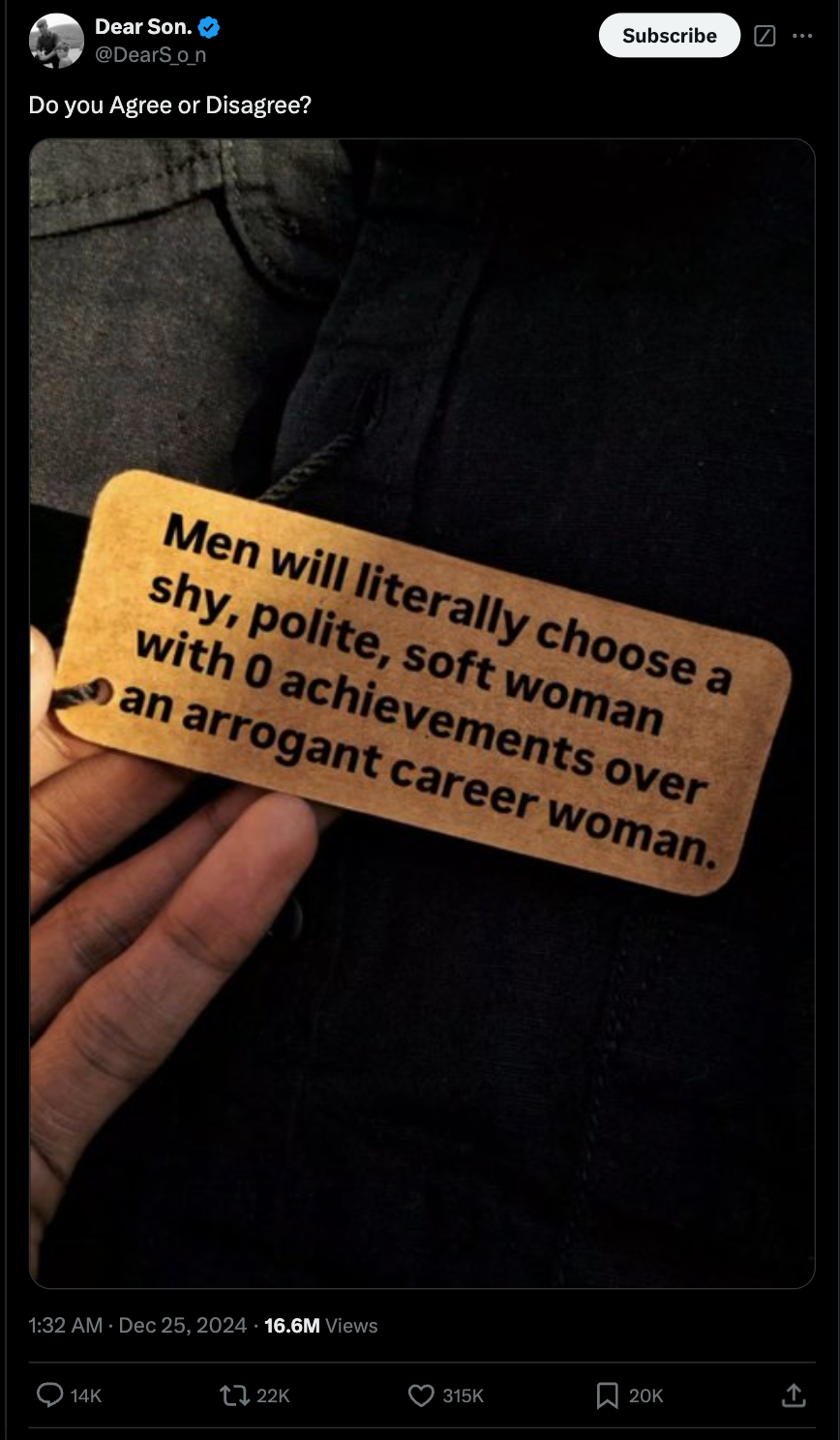
Before I met my husband I used to see posts like that, posts that are anti-female success and I would get so nervous. Because being a writer and an artist on my own accord was so important to me– actually, my writing was probably the most important thing to me for a lot of my adolescence and into young adulthood. But I also wanted to get married, I wanted to love and be loved in return. So I used to hear opinions like “men are intimidated by successful women” and worry that success and domestic felicity were mutually exclusive, like I would have to choose between being an artist and having a successful career and being intellectually fulfilled… or being loved…
BUT the statistics say that I actually had nothing to worry about. According to a study by The Hamilton Project, almost all financial demographics of women are getting married less and less over time, except for women who are high earners, who are getting married more.
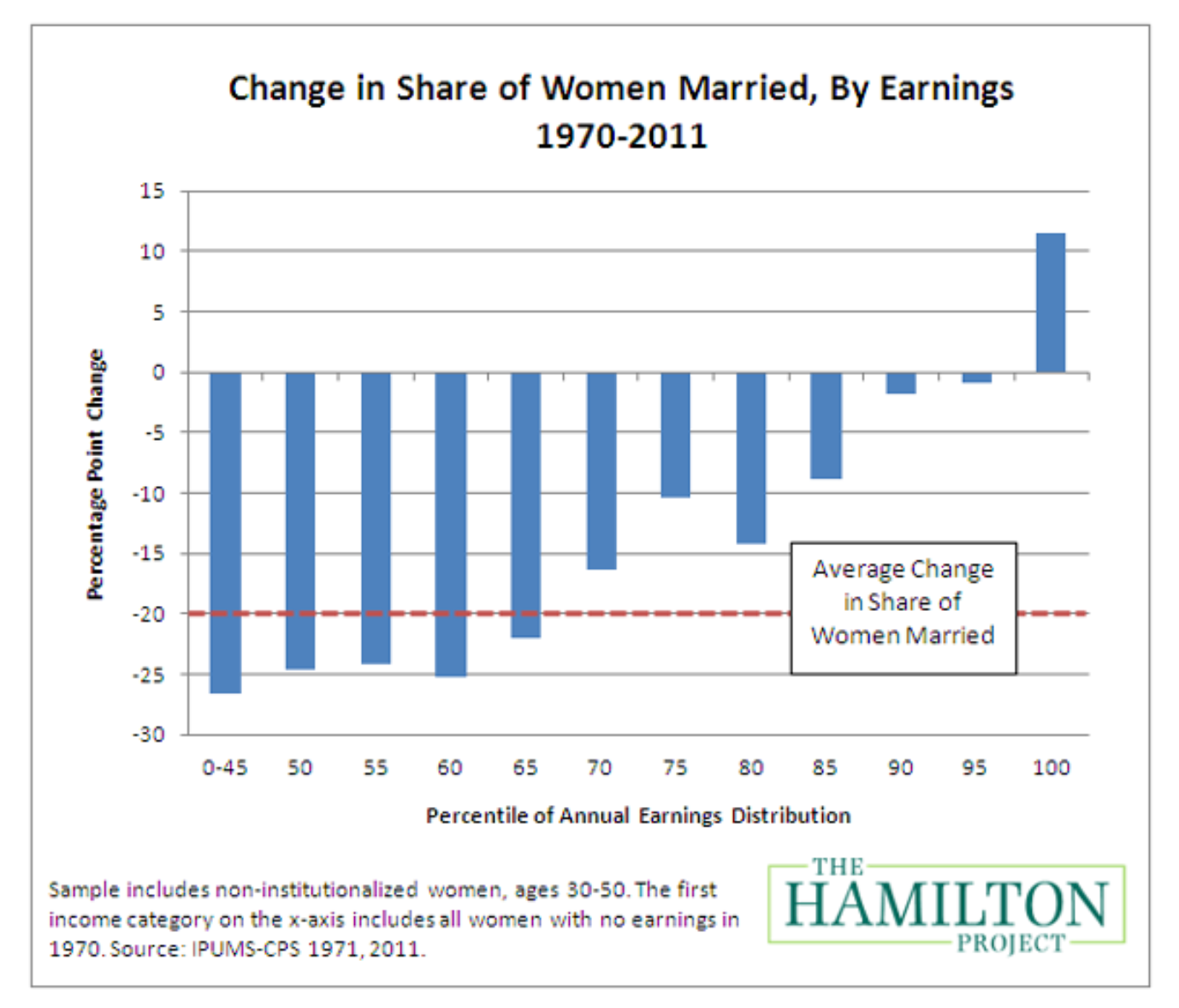
But sometimes people feel insecure or unloveable, and they think that seeking out a weaker or less accomplished spouse might make their spouse more easily impressed by them and less likely to leave them. And this isn’t a dating advice channel. But remember that for a long-term marriage, you aren’t just looking for somebody who is easy to boss around, you’re looking for a teammate: Someone to win with, not someone to win against. My grandfather, who had seven sons, always told them, the most important thing you will ever do for your kids is choose their mother.
But if you married young or had kids young and all of this sounds like doom and gloom, I really don’t mean to communicate that. If you notice, many of the forms of empowerment that I mentioned above are easily attainable. You don’t have to become an astronaut and run a Fortune 500 company all while being president of the PTA and packing homemade meals for your kids and husband every weekday. It’s simple things like building a social circle, learning about and potentially using birth control, finishing school, and making a budget to understand your household expenses. (I need to work on that last one.) You don’t need to get a PhD to be empowered; empowerment can come from reading great literature, experiencing mind-warping works of art, getting physically stronger, meditating, traveling to cultures entirely different from your own, talking to people with different opinions and ideas, ideas that make you mad, and make you argue, then make you realize you can’t defend the way you feel, which in turn causes you to question your whole life view. And maybe you’ll go through all these empowering experiences and realize that your opinions haven’t changed, and you were right along, but you have to go through your hero’s journey first; you have to go stare at a horizon line for long enough until the universe starts speaking to you.
And I also wanted to include the second article about the Hamptons people because I think it’s a great example about how these antiquated gender roles can also be toxic for men as well. These videos you see on social media (which I sometimes doubt the validity of) of girls saying they would never marry a man making 75k a year or they would never accept an engagement ring worth less than six figures are another offshoot of patriarchal thinking.
And if Brandon Miller was feeling so much economic pressure, as the son of a real estate mogul living in a $15 million Hamptons mansion that he fucking killed himself, then imagine how much pressure the young working class dad feels whose hours worked determine if his kids will eat that month or be taken away by the state. If Hannah Neeleman is driven to exhaustion by maternal responsibilities even as one of the heiresses of the Jet Blue fortune, then imagine how a single mom feels whose tips or commission will determine if her kids get to go to the doctor or not. And people with those concerns are far more numerous than the trad moms and rich husbands, they just don’t have the time to post TikToks every day.

You shouldn’t treat your spouse like a money-making machine in the same way that you shouldn’t treat your spouse like a baby-making machine. We all benefit when we recognize the humanity in one another. In Meditations, Marcus Aurelius writes that all beings in nature fulfill their purpose, and you, as a human, must do the same. The spider builds a web, the seed grows into a plant, fire rises, and stones fall. They do these things not because they are waiting for accolades or applause, but because it is their nature. So what is the nature of humans? Our destiny in the natural order of things? According to the Stoics, to be social and cooperative with the greater whole, to live in a way that is harmonious and aligned with nature, and to be good and virtuous. Thus, the greatest crime against nature that you can commit is that of unfulfilled potential. Marcus Aurelius wrote: “You have forgotten the value of your dignity, the worth of your potential. You were made for a purpose: to work with others in harmony.” Marcus Aurelius wasn’t against the accumulation of wealth, but he called wealth, “The smallest of things.”
So let the stories of the late debtor and the former ballerina be a warning of what can happen to a human soul when it is taken from its original fluid form and instead beaten down into a walking stereotype.
We are all far more complex than the roles that were assigned to us at birth. We’re more complex than what our parents expected of us. We’re more complex than what our children want from us. And we are more complex than who we thought we would be when we were kids.
Humanity is destined for far greater than the simple accumulation of material things and we’re destined for greater than a never-ending list of domestic chores. Both of those things are important parts of day-to-day human life! But they are not your entire identity. Your life, like nature, needs balance.
You are destined for more, fellow human. You are destined for harmony. It’s in your nature.
I’m Siobhan Brier Aguilar. I’m a writer. I have a monthly newsletter that you can sign up for on my blog. If you require writing, editing, or SEO services, I work through Inkless Writing Agency who you can contact by emailing info@inklessagency.com.





